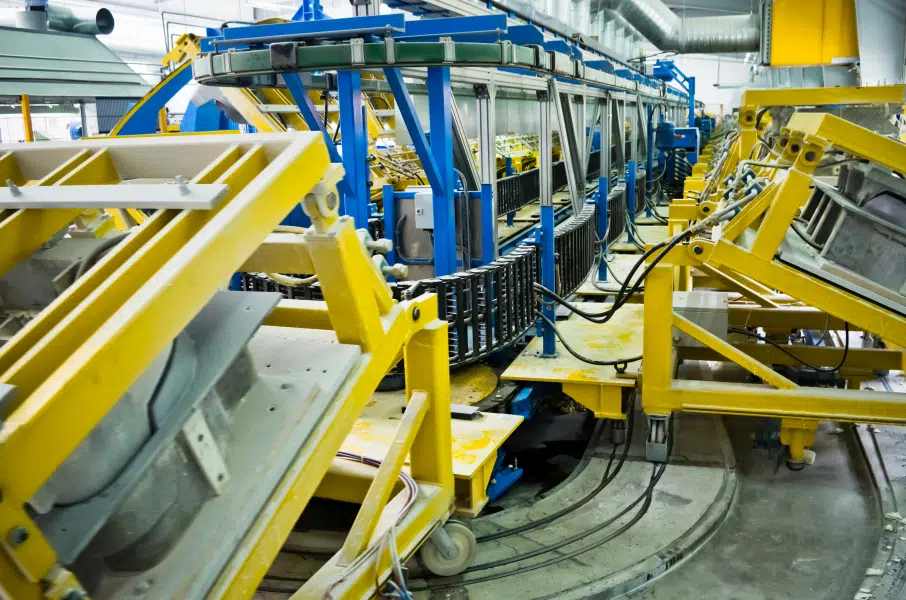Electric overhead and floor tracks
Rail-bound conveyor systems with self-propelled carriages
Electric Monorail Systems
Electric Monorail Systems (EMS) are used as overhead conveyor technology for automated transport over long distances. For the rapid creation of complex rail layouts, WinMOD-SIMLINE offers a 3D library with parameterisable rails, curves, switches, rail lifters and travel modules. The high-performance WinMOD-SIMLINE light and heavy-duty overhead trolleys are equipped with current collectors, code readers, magnetic switches and writable data fields, depending on requirements. Standard vehicles equipped with lifting, folding or rotating frames are used, as well as highly individual, tailor-made customer solutions.
Transport goods can be loaded and unloaded and, just like the EHB vehicles themselves, can be recorded with precise geometry by the WinMOD-SIMLINE 3D sensor technology. This allows the control/fleet management system with track & trace (RFID/barcode) to be tested and validated in a targeted manner. Even complex processes such as the coordination of multiple vehicles, switch controls, congestion behaviour or safe load handling can be simulated in detail.


Electric Floor Systems
Electric Floor Systems (EBB) are automated, floor-mounted conveyor systems used for the reliable transport of components, pallets or workpiece carriers over long distances within manufacturing and logistics facilities. They move along permanently installed rails and are controlled centrally.
The WinMOD-SIMLINE system offers a comprehensive 3D library with parameterisable double-deck rails with straight sections, curves and switches. The CAD-based 3D vehicles can be equipped with various load handling devices such as roller and chain conveyors, as well as real-time 3D sensor technology. Functions such as rail and code band communication, docking at stations, and loading and unloading are reproduced true to life. Control, drive technology, and sensor technology can be put into operation completely virtually and tested in conjunction with other automation systems.
Further factory automation solutions
Sorting and picking systems for small items such as cartons, plastic boxes or other piece goods. Transport is via classic roller conveyors, belt conveyors
as well as the typical cam roller conveyors found here,
Belt curves and accumulation roller conveyors.
This area of technology encompasses conveyor systems that transport and sort pallets and mesh boxes. The conveyor elements are large roller and chain conveyors combined with lifting, rotating and shifting tables. Magazines for empty pallets are also typical here.
These systems are usually fully automated high-bay warehouses that are operated by storage and retrieval machines and controlled by distributed automation systems. Warehouse management systems generate the orders for storage and retrieval.
Automated systems that pick up parts from A to B and place them down again with a defined orientation – typically for loading, sorting, picking or packing. Core systems are industrial robots (Delta, SCARA, 6 axes, Cartesian) or gantry axes.
Robotics plays a central role in modern manufacturing by enabling the automation of production processes and increasing efficiency and precision. Robots are used in various areas, such as welding, assembly, painting or packaging products.
Production lines combine processes, material flow and controls into a production system with guaranteed cycle times and quality. They consist of combinations of assembly, processing and testing stations. In addition, there is transfer technology, buffers and often a highly specialised automation system.
Electric Monorail Systems are used as connecting conveyor technology over long distances. The overhead trolleys run fully automatically with integrated electric drives and controls and are usually routed via a central control system.
This chain-driven overhead or floor conveyor technology is powered by continuously running power strands (chains). Transport trolleys are coupled in, transported, decoupled at stoppers and buffered via chain drivers („dogs“).
Automated self-driving vehicles as a connecting material flow solution. Driving is either completely trackless via defined tracks or markers (AGV) or via free navigation with automatic dynamic obstacle avoidance (AMR).
Engineering discipline for the development, manufacture and maintenance of machines, plants and production systems. Typical applications include machine tools, handling technology, automotive/aerospace, packaging and assembly plants.